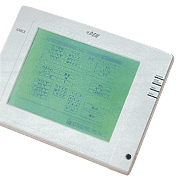Oki Electric’s if PEN 30 did away with the conventional keyboard found on nearly all computers and instead relied on a wireless pen for all inputs. The resulting user-friendly interface and superior portability allowed the if PEN 30 to be used in many more situations than ordinary computers.
All if PEN 30 operations and controls were made with pen gestures on the display screen. Entering Japanese text was made more efficient by including handwriting recognition software in addition to a conventional kana-kanji conversion function.
The if PEN 433 was announced in May 1994 with an upgraded 33 MHz i486 SX CPU.
| ifPEN30 | ||
| CPU | i386 SL 3.3-volt version (20 MHz) | |
| Memory | RAM | 4 MB standard (expandable up to 8 MB) |
| ROM | 256KB | |
| File storage | HDD | One 40 MB, 2.5-inch (half-height) drive |
| FDD | External 3.5/5.35-inch drive connected via a connector box | |
| Flash memory | Card-slot mountable (optional) | |
| Monitor | Display method | Monochrome LCD with backlight |
| Resolution | 640×480 | |
| Display control | VGA (able to display simultaneously with an external CRT) | |
| Input method | Wireless electromagnetic-induction pen and tablet | |
| Card slot | Standard equipped with one slot (PCMCIA/JEIDA-compatible) | |
| Expansion bus | Connector box interface | Connector box interface for peripheral connections |
| ISA bus interface | Interface for ISA board connections | |
| Communication and network functions | V.22 bis modem, fax/data modem, 10Base-T LAN card slot supported as an option | |
| Battery operation | Continuous operation: ~2 hours, Intermittent operation: ~4 hours | |
| External dimensions [mm]/ weight | 297 × 224 x 35 (w x d x h) / ~2 kg | |


